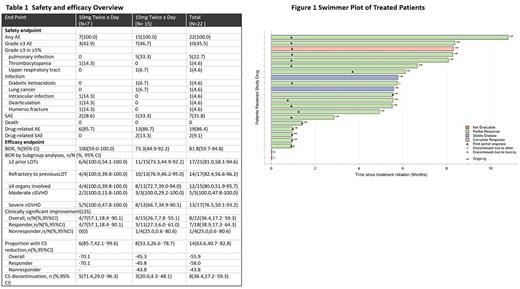Abstract
Introduction: Chronic graft-versus-host disease (cGVHD) is a serious complication of allogeneic stem cell transplantation that is a leading cause of morbidity, mortality, and impaired quality of life. It is an immune-mediated inflammatory and fibrotic disorder. The Janus kinase (JAK) signaling pathways play an important role in immune-cell activation and tissue inflammation during cGVHD. The rho-associated coiled-coil-containing protein kinase-2 (ROCK2) signaling pathway regulates Th17/regulatory T cells balance and controls profibrotic pathways involving in progression of cGVHD. TQ05105 is a novel, oral dual JAK1/2 and ROCK1/2 inhibitor targeting inflammatory and fibrotic components of cGVHD. Selective JAK/ROCK inhibition with TQ05105 may offer a novel approach to the management of cGVHD.
Methods: This phase1b/2, multicenter, open-label study of TQ05105 enrolled moderate or severe glucocorticoid-refractory or -dependent cGVHD patients who had received at least one prior lines of therapy (LOTs). This trial consist of 2 parts:a phase 1b dose escalation phase using a standard 3+3 design to determine the maximum tolerated dose (MTD) and recommended phase 2 dose (RP2D). Phase 2 of this study is a expansion of TQ05105 at RP2D. The initial dose is 10mg BID, then reduced to 5mg BID in the event of unacceptable toxicity and increased to 15mg BID in the absence of dose limited toxicity. The primary endpoint of Phase 1b portion of the study was safety and RP2D. The key secondary end points were the best overall response (BOR, complete or partial response) defined per the 2014 NIH Consensus criteria, failure-free survival (FFS) at 6 month and improved score on the modified Lee Symptom Scale (LSS).
Results: From May 2021, through May 2022, 22 patients were enrolled. Median age was 33 years (16-89), 63.6% male. The median time from cGVHD diagnosis to enrollment was 36 months. Patients enrolled in 10mg BID (n=7) and 15mg BID (n=15) had received a median of 4 prior lines of cGVHD therapy, respectively. 77.3% of patients had severe cGVHD. 57.1% of patients in 10mg BID and 53.3% in 15mg BID had involvement of ≥ 4 organs. The most frequently involved organs in 10mg BID and 15mg BID, respectively, are eyes (100%, 86.7%), mouth (57.1%, 93.3%), lungs (57.1%, 86.7%), skin (57.1%, 53.3%), and Joints and/or fascia (57.1%, 46.7%). The median treatment duration was 165 days (29-370).
TQ05105 was well tolerated without dose-limiting toxicities in two doses. The RP2D was not determined and enrollment is ongoing. Commonly reported AEs (≥20%) were Epstein-Barr virus infections (36.4%), pulmonary infection (31.8%), upper respiratory tract infection (31.8%), leukopenia (27.3%), neutropenia (27.3%), hypercholesterolemia (27.3%). Grade 3 or higher AEs were reported in 10 patients and SAEs in 7 patients. No apparent increase in incidence of infection was observed. No cases of cytomegalovirus (CMV) infection or reactivation were reported with TQ05105. As of the data cutoff, there was no death and no relapse.
Of the 22 patients, the BOR was 100% (7 of 7) in 10mg BID and 73.3% (11 of 15) in 15mg BID, and median duration of response was not reached. Responses were rapid, with 45% of responders achieving a response by the first assessment (at 4 weeks). Responses were achieved across key subgroups in 10mg BID and 15mg BID, with BOR of 100% (4 of 4) and 72.7% (8 of 11) in patients with ≥ 4 organs involved, 100% (6 of 6) and 73.3% (11 of 15) in patients who had received ≥ 2 prior systemic LOTs, 100% (4 of 4) and 76.9% (10 of 13) in patients who were refractory to their last LOT before enrollment,100% (5 of 5) and 66.7%(8 of 12) in patients with severe cGVHD. The FFS rate was 88.9% (95%CI, 43.3%-98.4%) at 6 months. During TQ05105 treatment, 85.7% (6 of 7) in 10mg BID and 53.3% (8 of 15) in 15mg BID reduced corticosteroids (CS) dose. 8/22 (36.4%) patients discontinued CS. 57.1% (4 of 7) and 26.7% (4 of 15) of patients in 10mg BID and 15mg BID, respectively, achieved an improvement (≥ 7 points reduction) in the LSS Score, including both responders and non-responders.
Conclusion: TQ05105 is well-tolerated for cGVHD and yielding high rates of clinical response, improving quality-of-life, reducing corticosteroids dose. The data indicated that TQ05105 may be proved to be a potential, effective therapy for patients with glucocorticoid-refractory or -dependent cGVHD. (Funded by Chia Tai Tianqing Pharmaceutical Group Co., Ltd. ClinicalTrials.gov number, NCT04944043)
Disclosures
Tu:Chia Tai Tianqing Pharmaceutical Group Co., Ltd.: Current Employment. Wang:Chia Tai Tianqing Pharmaceutical Group Co., Ltd.: Current Employment.
Author notes
Asterisk with author names denotes non-ASH members.


